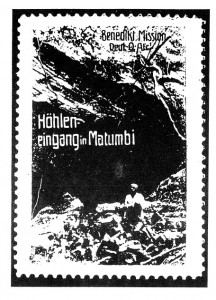The illustration is of a non-postage stamp showing the entrance of one of the Matumbi caves, produced about 1910 by the Benedictine Mission. The picture size is 45mm x 31mm and it is grey in colour.
Although limestone caves exist at Tanga and at Songwe, (Mbeya District), very little is known of others elsewhere in Tanzania. It was therefore with the greatest interest that I saw a cutting from the Cape Argus of 17th June 1911 describing the discovery of two sizeable caves in the Matumbi Hills, some 50 kms from the coast in Kilwa Province.
Library research revealed three more contemporary accounts. Two were in the Berlin magazine ‘Deutsches Kolonialblatt’ and the third in the publication of an Austrian cave-exploring society at Graz. The caves were first noticed and recorded in August 1909 by Police Sergeant Weckauf from Kibata. Investigating an isolated patch of forest, he was surprised to find the large entrance of the Nangoma Cave, used as a refuge in the fighting of a few years before by tribesmen who had left the forest uncleared to hide it. This entrance, 43m wide and 21m high, is at the bottom of a deep hollow in the limestone. Weckauf’s find came to the notice of Ambrose Mayer, a Catholic missionary at the Nambiligja mission, and in February 1910 both men went there together, exploring more of the Nangoma Cave and recording passage lengths which totalled 329m.
At the very end of 1910 the much larger Nduli Cave was visited and found to be 3,630m long. As cave lengths are so often exaggerated in popular accounts, I should emphasise that Mayer has given precise passage lengths for each part of the caves, as if measured, or at least paced, and the totals have been obtained by summing these.
A stream flows through the Nduli Cove and eels and fish were found in it. Many fruit bats were seen there also. ‘A passage at the back of the third hole, leading perhaps to the Nangoma Cave, could not be entered because the flying foxes hung on the head, chest and back of anyone coming in and flew against the lanterns so that they were in danger of being extinguished.
That the caves were moderately well known locally at this time is evidenced by the fact that the Catholic mission produced adhesive stamp-like seals, showing ‘cave entrance at Matumbi’ as illustrated here. It seems likely that these may have been sold for charity and they certainly date from the period when the country was still German East Africa.
One problem that I faced when attempting to discover more about the caves was that their exact location was not known. Thurmann had published his sketch map in 1911, but direct correlation of this with modern maps could not be done because the small area it covers made it impossible to fit the river pattern, especially in view of its unknown accuracy. Fortunately. a copy of the 1900 map used by Thurmann as a basis for his sketch exists in the Royal Geographical Society in London. It names the rivers referred to by Thurmann and so allows the cave locations to be determined in two stages from the 1911 sketch map to the relatively small scale map of 1900 in which details are often only approximate, and then from there to the large scale map of 1968. The river confluence close to the caves is at 8″ 28′ 34″ 5, 38° 48′ 23″ E (grid reference 4787 0633) and the Nangoma and Nduli caves are in grid squares 478063 or 4 78064. The presence, on the 1968 map, of a main track (motorable) from Nandembo to the village at Nakilago should prove useful for reconnaissance.
A cave more than 3.5 km long cannot easily be lost, but the Matumbi caves have attracted hardly any attention since their discovery. A brief mention of their bat guano was made in 1934 and 1948 but I have not been able to find anything else in the normal scientific end general literature. Then in 1966 a list of the world’s long caves included Nduli, but the length given is the same as that in the original accounts, so there had evidently been no subsequent exploration, or at least none recorded. Similarly no plan seems to have been made.
Of course Matumbi was not a tourist area and the caves had negligible economic value, but surely someone must have explored or at least visited them in the last 80 years or so. Dr Waane, the present Director of Antiquities for Tanzania tells me that he went there in 1985 though he di d not travel the full length of Nduli Cave.
DOES ANY READER OF THE BULLETIN KNOW OF ANY OTHER VISITS TO THE MATUMBI CAVES, RECENT OR LONG AGO? Perhaps there are photographs, diary accounts, articles in newspapers or magazines or mentions in regional guide books.
Trevor Shaw
Dr TREVOR R. SHAW is a retired Royal Navy officer who has made a life-long study of caves. His doctorate (as an ‘antique student’) was awarded for work on the history of scientific cave studies.

